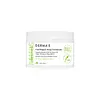What's inside
What's inside
 Key Ingredients
Key Ingredients

 Benefits
Benefits

 Concerns
Concerns

 Ingredients Side-by-side
Ingredients Side-by-side

Water
Skin ConditioningCetearyl Alcohol
EmollientBehentrimonium Chloride
PreservativeRicinus Communis Seed Oil
MaskingHydrolyzed Vegetable Protein
Skin ConditioningCetyl Alcohol
EmollientGuar Hydroxypropyltrimonium Chloride
Skin ConditioningHydrolyzed Wheat Protein
Skin ConditioningButyrospermum Parkii Butter
Skin ConditioningCocos Nucifera Oil
MaskingPrunus Amygdalus Dulcis Oil
Skin ConditioningPhyllanthus Emblica Fruit Extract
HumectantPersea Gratissima Oil
Skin ConditioningVitis Vinifera Seed Oil
EmollientSimmondsia Chinensis Seed Oil
EmollientSclerocarya Birrea Seed Oil
HumectantAllantoin
Skin ConditioningBiotin
AntiseborrhoeicGlycerin
HumectantBehenyl Behenate
EmollientTocopheryl Acetate
AntioxidantArctium Lappa Root Extract
Skin ConditioningCoco-Caprylate
EmollientYucca Filamentosa Root Extract
Carica Papaya Fruit Extract
Skin ConditioningMangifera Indica Fruit Extract
Skin ConditioningMenthone Glycerin Acetal
RefreshingMenthol
MaskingMentha Arvensis Leaf Oil
MaskingMentha Piperita Leaf
RefreshingEthylhexylglycerin
Skin ConditioningPhenoxyethanol
PreservativeWater, Cetearyl Alcohol, Behentrimonium Chloride, Ricinus Communis Seed Oil, Hydrolyzed Vegetable Protein, Cetyl Alcohol, Guar Hydroxypropyltrimonium Chloride, Hydrolyzed Wheat Protein, Butyrospermum Parkii Butter, Cocos Nucifera Oil, Prunus Amygdalus Dulcis Oil, Phyllanthus Emblica Fruit Extract, Persea Gratissima Oil, Vitis Vinifera Seed Oil, Simmondsia Chinensis Seed Oil, Sclerocarya Birrea Seed Oil, Allantoin, Biotin, Glycerin, Behenyl Behenate, Tocopheryl Acetate, Arctium Lappa Root Extract, Coco-Caprylate, Yucca Filamentosa Root Extract, Carica Papaya Fruit Extract, Mangifera Indica Fruit Extract, Menthone Glycerin Acetal, Menthol, Mentha Arvensis Leaf Oil, Mentha Piperita Leaf, Ethylhexylglycerin, Phenoxyethanol
Water
Skin ConditioningCetyl Alcohol
EmollientCetearyl Alcohol
EmollientCetrimonium Chloride
AntimicrobialBehentrimonium Chloride
PreservativePropylene Glycol
HumectantSimmondsia Chinensis Seed Oil
EmollientArgania Spinosa Kernel Oil
EmollientHydrolyzed Vegetable Protein Pg-Propyl Silanetriol
Skin ConditioningTocopheryl Acetate
AntioxidantPanthenol
Skin ConditioningEthylhexylglycerin
Skin ConditioningDimethicone
EmollientParfum
MaskingPhenoxyethanol
PreservativePotassium Sorbate
PreservativeDisodium EDTA
Citric Acid
BufferingAscorbic Acid
AntioxidantWater, Cetyl Alcohol, Cetearyl Alcohol, Cetrimonium Chloride, Behentrimonium Chloride, Propylene Glycol, Simmondsia Chinensis Seed Oil, Argania Spinosa Kernel Oil, Hydrolyzed Vegetable Protein Pg-Propyl Silanetriol, Tocopheryl Acetate, Panthenol, Ethylhexylglycerin, Dimethicone, Parfum, Phenoxyethanol, Potassium Sorbate, Disodium EDTA, Citric Acid, Ascorbic Acid
 Reviews
Reviews

Ingredients Explained
These ingredients are found in both products.
Ingredients higher up in an ingredient list are typically present in a larger amount.
This ingredient is a preservative and often used for it's anti-static properties. You'll most likely see this ingredient in hair conditioners.
It does not cause irritation or sensitization in leave-on products at 1-5%.
Cetearyl alcohol is a mixture of two fatty alcohols: cetyl alcohol and stearyl alcohol. It is mainly used as an emulsifier. Emulsifiers help prevent the separation of oils and products. Due to its composition, it can also be used to thicken a product or help create foam.
Cetearyl alcohol is an emollient. Emollients help soothe and hydrate the skin by trapping moisture.
Studies show Cetearyl alcohol is non-toxic and non-irritating. The FDA allows products labeled "alcohol-free" to have fatty alcohols.
This ingredient is usually derived from plant oils such as palm, vegetable, or coconut oils. There is debate on whether this ingredient will cause acne.
Due to the fatty acid base, this ingredient may not be Malassezia folliculitis safe.
Learn more about Cetearyl AlcoholCetyl Alcohol is a fatty alcohol. Fatty Alcohols are most often used as an emollient or to thicken a product.
Its main roles are:
Though it has "alcohol" in the name, it is not related to denatured alcohol or ethyl alcohol.
The FDA allows products labeled "alcohol-free" to have fatty alcohols.
Learn more about Cetyl AlcoholEthylhexylglycerin (we can't pronounce this either) is commonly used as a preservative and skin softener. It is derived from glyceryl.
You might see Ethylhexylglycerin often paired with other preservatives such as phenoxyethanol. Ethylhexylglycerin has been found to increase the effectiveness of these other preservatives.
Phenoxyethanol is a preservative that has germicide, antimicrobial, and aromatic properties. Studies show that phenoxyethanol can prevent microbial growth. By itself, it has a scent that is similar to that of a rose.
It's often used in formulations along with Caprylyl Glycol to preserve the shelf life of products.
This oil comes from the seeds of the desert shrub called Jojoba. It is more commonly known as jojoba oil, a non-comedogenic oil.
Jojoba oil does not contain fragrance and has many fatty-acids, making it a great soothing ingredient.
It also contains Vitamin E, a great moisturizing ingredient. Vitamin E is also an antioxidant and protects your skin against oxidative damage.
This ingredient humectant properties, meaning it helps draw moisture from the air. This helps keep your skin hydrated.
While jojoba has antibacterial properties, it is only able to kill some strains of bacteria.
Studies also show it helps in wound healing. In fact, Indigenous cultures have used jojoba as a moisturizer and to help treat burns for centuries.
Fun fact: Jojoba oil similar to natural human skin sebum, so it has a great effect on dry skin. It is also promising with helping to regulate sebum production.
Due to its fatty acid content, Jojoba oil may not be fungal acne safe. We recommend speaking with a professional if you have any concerns.
Learn more about Simmondsia Chinensis Seed OilTocopheryl Acetate is AKA Vitamin E. It is an antioxidant and protects your skin from free radicals. Free radicals damage the skin by breaking down collagen.
One study found using Tocopheryl Acetate with Vitamin C decreased the number of sunburned cells.
Tocopheryl Acetate is commonly found in both skincare and dietary supplements.
Learn more about Tocopheryl AcetateWater. It's the most common cosmetic ingredient of all. You'll usually see it at the top of ingredient lists, meaning that it makes up the largest part of the product.
So why is it so popular? Water most often acts as a solvent - this means that it helps dissolve other ingredients into the formulation.
You'll also recognize water as that liquid we all need to stay alive. If you see this, drink a glass of water. Stay hydrated!
Learn more about Water